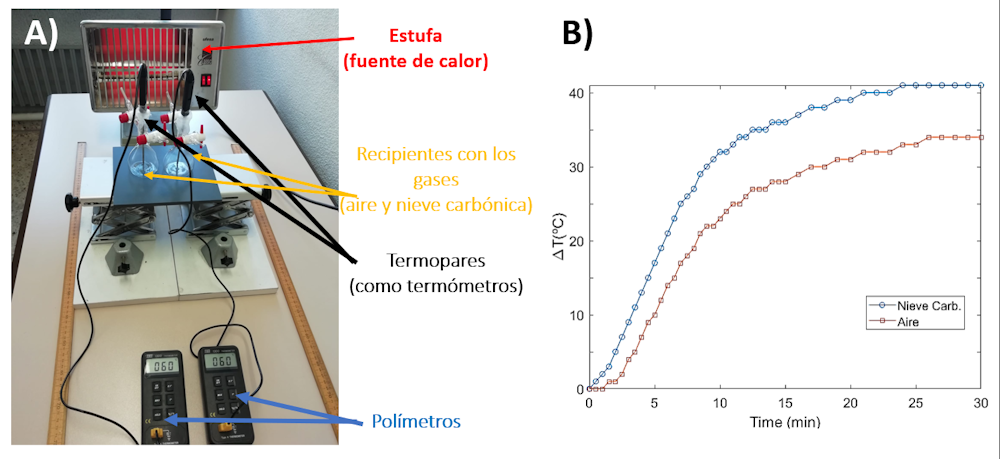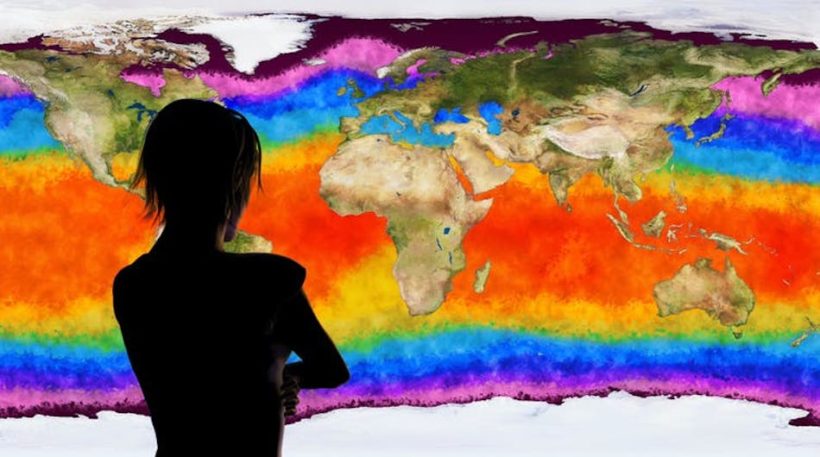This is an opinion piece by Ana García Page, PhD candidate in Theoretical Condensed Matter Physics at the German Max Planck Institute for Chemical Physics of Solids, and José Ramón Ares, Professor of Physics at the Autonomous University of Madrid.
In recent years, there has been a worldwide concern about climate, largely due to the increasing frequency of extreme weather events, as well as the significant rise in temperature.
What is even more worrying is that scientific evidence has pointed to humans as the cause behind all these phenomena that threaten us. This fact, as well as the silent way in which it endangers our lives, is what has so intensely mobilised people in many different countries, as shown, for example, by the international movement Fridays for Future.
Many movements similar to this one were started a few decades ago, when the ozone hole and the greenhouse effect were widely publicised in the media.
However, very few people know that one of the main ingredients of this climate change, the greenhouse effect, was actually discovered by a woman: Eunice Foote.

The Troy female seminary (Rensselaer County. N. Y.), where Eunice Foote learned chemistry and biology. Drawing: Library of Congress The first steps of an amateur scientist
Eunice Foote was born in 1819 in Goshen (Connecticut, USA) into a humble family; her father was a simple farmer. Although she had no higher education, her parents wanted their daughter to receive a scientific education and sent her to Troy Female Seminary. There she was able to learn chemistry and biology, mainly with an experimental approach, for two years.

Ana García Page This was undoubtedly the germ of a facet of her character that would mark her whole life: she never lost her curiosity and remained what we would call today an amateur scientist.
In addition, Eunice Foote had a strong character and clear convictions: she believed that women also had the right to be as free as men and to receive a higher education.
This is what led her and her husband Elisha Foote, a statistician and judge, to sign one of the world’s first women’s rights conventions in New York in 1848: the Seneca Falls Convention. Only two years later, she made the greatest (known) discovery of her career: the greenhouse effect.
A homemade experiment
Thus, in 1850, in a laboratory in her own home, she performed the following experiment: She introduced different gases (ordinary air, hydrogen and CO₂) into closed containers. Inside these containers was also a thermometer to measure the inside temperature.
She then exposed these gases to sunlight and observed the temperature changes. Thus, she discovered that not all gases heat up in the same way. CO₂ seemed to absorb the most heat.
She also observed that humidity is another crucial factor for heating (the more humid, the more heat is absorbed). It is known that there is a direct relationship between temperature and the microscopic motion of particles: the higher the temperature of a gas, the more its particles move. Therefore, air molecules are able to absorb incoming heat by transforming it into molecular motion.
Eunice’s was a fairly simple experiment that can easily be done at home. In fact, figure 1, corresponding to a similar experiment conducted by the authors of this article during this year’s European Researchers’ Night, shows how the temperature measured in vessels with CO₂ inside increases more than in those with only air.

Experimental set-up (A) and heating results (B)
Implications of the experimental
Despite their simplicity, the results of their experiment have profound consequences. Eunice quickly realised the implications of her results, as she knew from her scientific background that the composition of the atmosphere has changed over time. Therefore, the temperature of the atmosphere must also have changed over time. Moreover, if the composition of CO₂ in the atmosphere changed in the future, the climate would also change.
What the researcher did not know was that, in fact, above her head (or below her feet), there was a vivid example of her discovery: Venus.
Venus is not the closest planet in our solar system to the Sun, but it is nevertheless the one with the highest atmospheric temperature. This is due to the dense atmosphere, with terrifying colossal clouds of CO₂ and even sulphuric acid.

Image of clouds in the atmosphere of Venus. ESA / MPS / DLR / IDA
Despite today’s Dantesque image, it is believed that in the past Venus was quite similar to our peaceful planet: a habitable place. Something terrible happened in its past history that caused it to become the hell it is today: Venus is nothing more than a warning sign in our skies that tells us how things can be if we are not responsible enough for our actions.
A woman in a man’s world

Eunice Newton Foote’s article, Circumstances Affecting the Heat of the Sun’s Rays, published in the American Journal of Science. Despite this enormous discovery, Eunice Foote was not a professional scientist and, even worse, she was a woman in a century when women were not taken seriously.
It was therefore a colleague of hers, Joseph Henry of the Smithsonian Institution, who presented her research – published under the title Circumstances Affecting the Heat of the Sun’s Rays – at the conference of the American Association for the Advancement of Science in 1856.

José Ramón Ares Henry was very impressed by her study, which he considered to be of higher quality than the others presented at the conference, and decided to add a preface to the research: “Science belongs to neither country nor sex. The sphere of woman embraces not only the beautiful and the useful, but also the true.
However, perhaps because it was after all a woman’s work, it was not even published in the conference summary.
In addition, a year later, John Tyndall, who was a professional scientist and therefore had far more means to do these experiments, published a paper in which he reached the same conclusions as Eunice.
It is not yet clear whether he was aware of Eunice’s research, quite possibly not, but what is known for sure is that he did not cite her. The American’s work then fell into oblivion and John Tyndall went down in history as the first person to discover the greenhouse effect.
However, history itself had a better place in store for Eunice Foote than the memory drawer. In 2010 Eunice’s work was recovered and with it a fact was exposed: it was Eunice, a woman, who was the first person to discover it.
Eunice Foote’s name in the 21st century.
More than 10 years have passed since that rediscovery and hardly anyone still knows that the greenhouse effect was discovered by a woman.
Hardly anyone knows Eunice Foote. One wonders whether this would be different if it had been a man. Although we cannot know for sure, there have been more than enough cases in the history of science not to suspect at least some gender discrimination in Eunice’s story as well.
Some of the most shameful examples in our scientific community are the exclusion from the Nobel Prize of Rosalind Franklin, the first person to discover the double helix structure of DNA, or Jocelyn Bell, the discoverer of those beacons of the cosmic oceans, the pulsars.
With greater media impact and more topical, many voices have also been raised in recent months to point out and protest that no woman has won a scientific Nobel Prize this year either.
Despite the fame of these awards, in reality this clear inequality among award recipients is just the tip of an iceberg of exclusion and discrimination that persists in our community.
Perhaps in the shadows under which she was forced to live, as with many other women we still know nothing about, Eunice was pointing the way not only to being better as a species, being more aware of the consequences of our actions, but also to being better human beings in the present.






